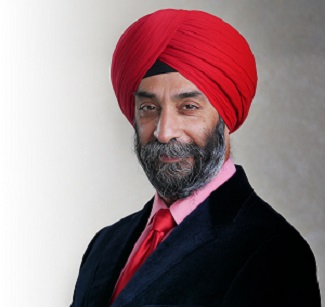
Change is said to be the only constant and, in business, change is prompted by the constant need for growth. But how can B2B organizations better manage, nurture, and capitalize on the many types of change to produce meaningful growth? There’s one powerful discipline that I have seen work time and again, but still gets too little attention in B2B organizations: branding.
That’s why this month in The B2B CMO we’re offering expert input on the subject of managing, instigating, and optimizing change through brand.
We spoke with an industry leader with great depth and breadth on the topic of change and brand:
- Mohanbir Sawhney, PhD, noted marketing and management consultant, author, and McCormick Foundation Chair of Technology, Clinical Professor of Marketing, and Director of the Center for Research in Technology & Innovation at the Kellogg School of Management.
SEE ALSO: From the Land Where “Brand” Was a Dirty Word: The B2B Branding Roundtable
We also talked to two senior marketers who have helped guide their share of change in B2B organizations:
- Jim Merkel, Executive Director, Corporate Sales & Marketing for Scot Forge a 123-year-old, 100% employee-owned, mid-size organization providing forged metal products from the most basic to the most demanding (e.g., the wheels for NASA’s Curiosity Rover).
- George Parr, Senior Vice President and Chief Marketing Officer for SIRVA Worldwide, a global leader in executive relocation and consumer moving.
We discussed the various types of business change: proactive vs. reactive, transformational vs. incremental, and on-going. As a rule, change is almost always tied to a trigger event such as the arrival of a new CEO, or an acquisition that requires integrating two entities into one, or a marketplace disruption that demands an organization change (or face irrelevance).
The important exception to the “trigger” rule is found in a truth applicable to all businesses — that the constant need for growth, itself inherently a form of change, requires marketers to proactively leverage brand as a tool in the growth plan.
Our conversations illuminated several key realities I’ve long noted in helping dozens of B2B companies capitalize on moments of change:
- Change is about growth
- Brand can help accelerate and improve the outcomes of change and growth initiatives:
- Internally, brand helps create and sustain cultural change and alignment
- Externally, brand helps transform buyer attitudes, beliefs, and behaviors
- Marketers can improve outcomes of their organization’s change efforts, and elevate their own positions in the process, when they strategically act in the role of change agent
Change is about growth
“The biggest hurdle, the biggest need for change,” says Sawhney, “comes from an inability to grow in a sustainable and a profitable way. A lot of the problems we see companies get into, like mergers or de-merging, as in the recent announcement that Xerox is going to split up, comes down to growth. In that case, they’ve only been able to grow their top-line … but their revenue growth is negative.”
The direct relationship between change and growth is precisely why brand marketing, and the CMOs that lead it, can have such a positive impact. After all, their ability to understand the customer and create strong brands to serve them is key to creating stronger top and bottom lines.
RELATED: Growth Path to Iconic Status
Brand change demands organizational change
There are two basic ways that B2B companies look at change, according to Sawhney:
“One is what I call the superficial approach—or putting lipstick on a pig. Then, there is the more fundamental approach, which is real transformation. Branding is an  articulation of your organization’s purpose and customer promise. Re-branding in an effort to change customer perceptions and experience can only truly be effective if it goes hand-in-hand with a more fundamental change in how you deliver on your promise to the customer — beyond what you say or how you communicate it. What I sometimes see are companies pursuing this exercise only to the extent of ‘We’re going to change our logo’ or ‘we’re going to change our brand’. For example, American Airlines recently changed their logo and repainted all of their planes. But the service still sucks and they’ve done nothing new about what’s inside the plane.”
articulation of your organization’s purpose and customer promise. Re-branding in an effort to change customer perceptions and experience can only truly be effective if it goes hand-in-hand with a more fundamental change in how you deliver on your promise to the customer — beyond what you say or how you communicate it. What I sometimes see are companies pursuing this exercise only to the extent of ‘We’re going to change our logo’ or ‘we’re going to change our brand’. For example, American Airlines recently changed their logo and repainted all of their planes. But the service still sucks and they’ve done nothing new about what’s inside the plane.”
Not exactly a formula for growing a customer base and the additional revenue that goes with it. Of course, what he’s describing is what countless change projects have taught me to call the “Be. Do. Say.” principle.
In short, to create sustainable growth through change, an organization must follow “Be. Do. Say.” First, an organization must define what it aspires to “Be” — the vision and outcome of the change and what aspects of the business it is committed to meaningfully transform (e.g., improvements in product, culture, brand, operations, policies, customer experience, etc.) in order to realize that vision. These changes must then be put into action — it is the “Do-ing” that makes the change self-evident. Only after “Be” and “Do” are well established can, or should, you “Say” anything through major statements in branding and marketing.
Proof of change must come first; brand and communication follow.
When organizations get this sequence out of order, and begin Say-ing before their Be-ing and Do-ing, the consequences are visibly evident and inevitably counterproductive. The American Airlines example Sawhney mentions illustrates this.
Internally, brand can help create and sustain cultural change and alignment
Building that evidence of real change begins internally, and here is another place where brand can really shine. A good branding process will dig down to your foundations, helping the organization discover its true purpose and honest promise, and define its unique beliefs and value system. Internal brand communications and training can then disseminate and amplify this brand essence, using it to align merging cultures, refocus a workforce, and motivate employees to consistently deliver the all-important customer experience.
SEE ALSO: No Brand Is Safe in the “Age of Disruption”
However, there is a caveat, as Sawhney frankly councils, saying:
“If you are going to use a brand as a vehicle to communicate the culture, then cultural change needs to be authentic and it needs to be deep seated. It needs to be led from the top and be embraced by everybody. One of the most common mistakes I see in this context is that you hire a branding agency, and your marketing people and brand teams sit in smoke-filled rooms and come up with the new brand and slogan, and then try to use that as a way to drive cultural change. The problem is that if employees aren’t brought into it — if nobody engaged them —, then they think, ‘Okay, so here is the new slogan. So what?’ There’s an acronym for how they feel, BOHICA, or ‘Bend over! Here it comes again.’ This shows just how deep employee skepticism can run when it comes to change. People see cultural change as something that needs to be reflected in behaviors, not just in slogans.”
Externally, brand can transform buyer attitudes, beliefs, and behaviors
Ultimately, brand unifies, equalizes, and empowers internal culture not for the corporation’s sake, but for the customer’s.
George Parr of SIRVA offers this about brand-led change, which can often be confused as an inwardly-focused effort only:  “It all starts with insights,” he says. “Everything begins and ends with the customer. The companies that are great marketing companies are not great because they have a terrific marketing function. It’s because everyone in the company is focused on delivering exceptional outcomes for their target segments, doing that consistently over time, and understanding how they each play a role [in those customer outcomes].”
“It all starts with insights,” he says. “Everything begins and ends with the customer. The companies that are great marketing companies are not great because they have a terrific marketing function. It’s because everyone in the company is focused on delivering exceptional outcomes for their target segments, doing that consistently over time, and understanding how they each play a role [in those customer outcomes].”
But, once again, the promises to customers built out of those insights must prove out in practice. “The CMO, as brand steward, must also ensure that the promise — as articulated in your messaging — is actually what the customers are experiencing,” says Sawhney. “Because what is the brand at the end of the day? A brand is the sum total of the experiences that customers have across all touch points. The brand is really the memory of an experience. If there is a dissonance or disconnect between what people hear about through communications and what they actually experience, then it really hurts you in the long run. What I would try to do as a CMO is to provide stewardship and orchestration, and try to get inserted more strategically in the conversation, so that I could push for authenticity.”
The frustrating thing for many marketers about authenticity is that, by definition, it can’t be manufactured. It has to be discovered, revealed. That’s why Scot Forge, when they noticed their marketplace started to change, began to listen more closely.
According to Jim Merkel, their Executive Director of Corporate Sales & Marketing, “We held very formalized listening events.  We brought a cross-functional team, with the majority not in a customer-facing role, to a host of customers, to listen and understand where their challenges are. They each had different wants and needs — and that’s where we developed some of the segmentation and specialization that we’ve done. Our goal was to connect our employees to our customers, so that they can feel the difference that our employee ownership culture makes. It also gave us direction on how to better support our customers’ needs. In the past, it might have been one person as a direct contact. Now customers are interacting with a team, they have a direct hotline to new technical resources, things like that.”
We brought a cross-functional team, with the majority not in a customer-facing role, to a host of customers, to listen and understand where their challenges are. They each had different wants and needs — and that’s where we developed some of the segmentation and specialization that we’ve done. Our goal was to connect our employees to our customers, so that they can feel the difference that our employee ownership culture makes. It also gave us direction on how to better support our customers’ needs. In the past, it might have been one person as a direct contact. Now customers are interacting with a team, they have a direct hotline to new technical resources, things like that.”
The upshot? Meaningful improvements in customer segmentation, service, and satisfaction from a brand that listened and changed to be more of what they heard customers say that they needed.
RELATED: The Role of the B2B CMO in Innovation
Marketers improve outcomes, and elevate their own positions, when they strategically embrace the role of change agent
The CMO is starting to be recognized as a change leader in some of the best B2B organizations — once they’ve secured a seat at the strategy table. “Beth Comstock at GE has been very much a part of that change conversation,” says Sawhney. “In fact, she owns the growth and innovation initiatives at GE. Of course, she has now become the vice chairman at GE, so that illustrates just how much of a seat at the table she had. I see this at other companies, too. At Emerson Electric, CMO Kathy Button-Bell has really been driving that conversation strategically. And at Microsoft, Chris Capossela has a lot of credibility in the organization and he is a key right hand person to Satya Nadella [Microsoft’s CEO]. It’s happening, but there is still a very small minority of B2B CMOs that really has that seat at the table. Partly it’s the leadership team that is to blame, but partly I think it’s the CMO’s duty to elevate his/her role.”
There are a number of ways that CMOs can boost their profiles and influence. Sawhney advises marketers to “demonstrate the value that marketing adds to the top-line growth, to revenues, to market expansion — that is the kind of value that most CEOs understand. Some CEOs don’t understand the value of brand and brand equity at all, but they get it when you tell them ‘I can help you drive growth. I can be a growth partner.’ That’s how you can elevate your role inside the company and get more strategic — first demonstrate how marketing drives growth rather than just creates communications.”
Parr concurs, saying, “Look for opportunities where, in helping the business, you can demonstrate what’s possible for marketing. Give them that experiential evidence.”
A final word for marketers who want to be change agents
At the end of our conversations, I asked how CMOs or other senior marketers can best position themselves for a role in creating and managing change in B2B companies.
SEE ALSO: Lessons in Leadership from the Top-Rising, Most Powerful Brands
“I like to say that there are 3 Ps,” replied Parr, “patience, perspective, and perseverance. You really have to come in with what I call a missionary mindset. Look for opportunities where, in helping the business, you can demonstrate what’s possible for marketing. Give them that experiential evidence. Having that perspective is key, along with establishing the right pacing for the organization. The worst thing you can do coming into a B2B organization as a new CMO is to move at one speed while the rest of the organization is moving at another. Then, the last thing is perseverance. There are going to be days where you feel you’re not getting anywhere. But if you’re doing your job effectively, if you’ve got that missionary mindset, if you’re striving for the experiential evidence and the business is benefiting from the new initiatives that you’re putting into place, eventually the organization is going to get there. You just have to keep at it. If it was easy, everybody would be doing it, right?”
What change challenges do you face and how are you meeting them? Please join the conversation by leaving your comments here. And be sure to come back next month for another edition of The B2B CMO.
Image: Elizabeth Lies
